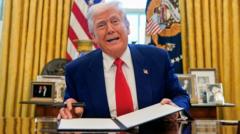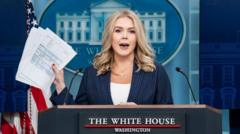Trump's executive order aims to enhance coal mining and usage, but environmental impacts raise significant debates.
**Trump's Upcoming Executive Order to Bolster Coal Industry Sparks Concerns**

**Trump's Upcoming Executive Order to Bolster Coal Industry Sparks Concerns**
The Trump administration moves to reinvigorate the coal sector amidst declining energy demands and environmental concerns.
In a bold move to revive the dwindling coal industry, President Trump is set to unveil an executive order that would facilitate coal leasing, mining, and the exploration of coal's role in powering emerging technologies like A.I. data centers. According to White House officials, the order will instruct federal agencies to ease current environmental regulations that have hindered coal projects, and could designate coal as a critical mineral, expediting federal approvals for new coal mines.
This policy shift comes as coal has fallen out of favor in the American energy market, supplanted by cheaper and cleaner alternatives such as natural gas, wind, and solar power. Notably, the past two decades have witnessed a dramatic decline in coal usage, which accounts for about 40% of global carbon emissions—primarily driving climate change. Critics of the executive order are wary, pointing out that coal's pollution not only contributes to climate-related disasters but also poses serious health risks linked to respiratory and cardiovascular diseases.
In attempts to bolster this obsolete energy source, the administration’s various stakeholders, including Energy Secretary Chris Wright, have championed the local and national significance of coal. "Our clean, beautiful coal is unmatched," asserted President Trump during a recent Oval Office meeting.
Despite these optimistic views, analysts remain skeptical about the efficacy of such regulatory rollbacks to reverse a trend that has seen the coal industry’s capacity severely diminish, with projections indicating further retirements of operational coal plants. Over recent years, coal's share in the U.S. energy mix has been declining while cleaner technologies gain momentum, contributing to a drop in national emissions since 2005.
As the administration pushes for more coal mining on federal lands, the discussions surrounding Trump's order exemplify the polarizing nature of energy policy in America. The balance between economic revival and environmental stewardship continues to be a contentious point, sparking a debate over whether the move signifies a needed revival or merely a political gesture against greater global trends pushing for a green energy future.
This policy shift comes as coal has fallen out of favor in the American energy market, supplanted by cheaper and cleaner alternatives such as natural gas, wind, and solar power. Notably, the past two decades have witnessed a dramatic decline in coal usage, which accounts for about 40% of global carbon emissions—primarily driving climate change. Critics of the executive order are wary, pointing out that coal's pollution not only contributes to climate-related disasters but also poses serious health risks linked to respiratory and cardiovascular diseases.
In attempts to bolster this obsolete energy source, the administration’s various stakeholders, including Energy Secretary Chris Wright, have championed the local and national significance of coal. "Our clean, beautiful coal is unmatched," asserted President Trump during a recent Oval Office meeting.
Despite these optimistic views, analysts remain skeptical about the efficacy of such regulatory rollbacks to reverse a trend that has seen the coal industry’s capacity severely diminish, with projections indicating further retirements of operational coal plants. Over recent years, coal's share in the U.S. energy mix has been declining while cleaner technologies gain momentum, contributing to a drop in national emissions since 2005.
As the administration pushes for more coal mining on federal lands, the discussions surrounding Trump's order exemplify the polarizing nature of energy policy in America. The balance between economic revival and environmental stewardship continues to be a contentious point, sparking a debate over whether the move signifies a needed revival or merely a political gesture against greater global trends pushing for a green energy future.




















